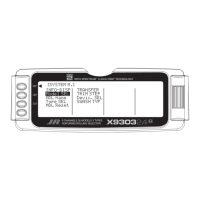PROG MIX 1-6 – PROGRAMMABLE MIXES 1 through 6
H-33
The X9303 2.4 System provides 4 Standard
programmable mixes (PROG.MIX3 through PROG.MIX6)
and 2 Multi-Point programmable mixes (PROG.MIX1 &
PROG.MIX2). Programmable mixes are used whenever
the pilot wants a channel to react or move as a result of
providing input to another channel, or to simply cause a
channel to move by moving a switch or lever. They are
typically used to compensate for deficiencies in helicopter
design/setup such as eliminating a pitch-to-aileron, or
pitch-to-elevator trim change issue when collective is
given. They are also used to activate special helicopter
functions like Retracts, Landing Lights, etc.
Multi-Point Mixing provides the ability to define a
customized “curve” of travel that the Slave channel will
follow as it reacts to the Master channel. It is different
from Normal Mixing in the sense that Normal Mixing
results in a linear movement of the Slave channel in
relation to the Master. With Multi-Point Mixing there are 7
points (includes end points) along the travel of the Master
channel that can be adjusted to control the action of the
Slave channel (more or less travel in the same/opposite
direction) and provides the ability to deviate from a linear
mixing action.
The channel that receives the original input from the pilot
is called the Master channel, while the channel that reacts
to the Master is called the Slave channel. Mixing occurs
when the pilot provides an input to the Master channel
or by moving a stick, switch, or lever. The transmitter
automatically generates an input for the Slave channel
based on the pilot’s input to the Master channel and the
parameters defined in the programmable mixer.
Mixes are programmable, allowing any of the 9 channels
to be Master, Slave or both. Additionally there are 4
options for Master channels that begin with a “#” (pound
sign), these Master channels are origin type mixes. These
include #AIL, #ELE, #RUD, and #PIT. Origin mixing
bypasses any other mixing that might affect that channel
such as throttle curves or other programming and uses
the stick position only to control the mix. There are also 4
options for Master channels that end with a + sign, these
Master channels are include type mixes. These include
THR+, ELE+, AIL+, and RUD+. Include mixes include the
trim of the Master channel as well as any other mixing
to the Master channel to control the Slave channel of the
mix. The Timer, TIMT, switch (momentary switch) can
also be set as the Master channel of a mix.
The mixing parameters are also programmable and
include the direction of travel of the Slave channel; the
amount of travel for the Slave channel; the Offset (where
the mix starts and changes direction) and the switches/
levers/sticks that are used to turn a mixer on and off.
All of these elements are selectable and adjustable in
Programmable Mixes.
Some examples of how programmable mixers might be
used include but are certainly not limited to:
• Swashplate Timing: Improves Rolling and
Vertical Maneuver tracking
This is a condition when the heli will not roll on its axis
(tail boom) correctly, or pulls to the Left or Right during
pitching Maneuvers (loops, stall turns, etc.)
Most Helis need and can benefit from this form of mix to
improve their overall flight performance. This trick mixing
is used by most of the pros to make their models fly more
accurately, and in turn, more easily.
2 Separate Mixes are required
Mix 1: Elevator to Aileron (Corrects vertical
tracking)
By using a program mix Elevator to Aileron to correct an
Vertical pull/ issue, the mix will allow the Aileron servo
to move slightly in the opposite direction of the out of
track direction in order to keep the aircraft from pulling
left or right when a vertical maneuver is performed. This
standard mixer would designate the Elevator as the Master
and the Ailerons as the Slave.
Mix 2: Aileron to Elevator (Corrects Rolling
Manauvers)
To add swashplate timing for Rolling maneuvers, a similar
mix of Aileron (Master) to Elevator (Slave) would be
created additionally. For these types of mixes, you would
use Standard Program Mix, numbers 3 through 6.

